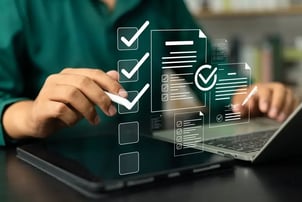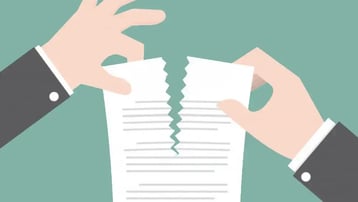The tender response process involves a series of steps that are designed to guide your team from pre-qualification to contract. By investing a little effort into planning this process, you can save time and position your business for growth.
This blog equips you with the steps and tactics you need to enhance your tendering capabilities and achieve long-term success.
Tender Response Process Efficiency
Following a process is important because it lays the foundation for more organized proposal development. This optimizes everyone’s time, focuses their efforts on the priorities, and delivers a higher-quality result.
When planning your response process, here’s a good rule of thumb. Divide available time into three phases. This provides ample time for review and improvement, and packaging and delivery.
- 25% – reading and planning the response
- 50% – compiling the response
- 25% – reviewing and refining the response
Analyze
The tender documents are your instruction manual for building your response. In between the lines you can also find valuable information for tailoring your proposal. For example, selection criteria is typically based on their priorities.
Read carefully, and identify specifics, for example:
- Scope of Work: Tasks, deliverables, and timeline.
- Job Requirements: Roles and responsibilities, milestones and deliverables.
- Selection Criteria: How the organization weights each requirement or section.
- Pricing: Price structure and charging mechanism, terms, conditions, and penalties.
- Submission Requirements: Format and deliver requirements.
Determine if the Project is Good for your Business
Each invitation to submit is an opportunity for new business and growth. However, only if the project can deliver on your expected return on investment. The bid/no bid process involves evaluating a number of project factors.
Determine if this tender is a good fit by asking:
- Does the project align with our strategic goals and objectives?
- Do we have the capabilities and capacity necessary to fulfill the contract?
- Do our strengths outweigh those of the competition?
- Is the likelihood of winning the bid worthy of the investment?
- Are the potential financial and operational risks worthy of the investment?
Strategize to Win
A tender response involves much more than simply responding to a questionnaire. It involves humanizing your solution to connect with readers and evaluators. This is where your pursuit, or capture, strategy comes into play.
Your strategy details what you know and how you will use it to deliver a winning response.
- Position: How you will solve the client’s problem.
- Gaps: How you will counter requirement gaps.
- Concerns: How you will address potential objections.
- Risks: How you will mitigate potential risks.
- Competition: How you will stand out from your competition.
- References: How you will demonstrate proof of your outcome and value.
Plan your Tender Development
Request for proposals often involve substantial contracts that can significantly impact your business's revenue. They are also often large, complex, and time-consuming to pull together. By planning, and making key decisions up-front, you smooth the way for a successful outcome.
Focus your planning on the following elements:
- Resources: Identify the experts, develop a budget and define the timeline.
- References: Identify past projects that support your argument.
- Documentation: Gather financial, CVs, or resumes, and certifications.
- Writer’s Package: Define how your team will articulate your strategy.
- Templates: Breakdown volumes, documents, sections and project requirements.
Assemble your Team and Kick-off
The kick-off meeting typically occurs within two to three days of receiving the documentation. It involves bringing your team together and bringing them up to speed on the tender. However, it is also an opportunity to inspire and motivate your team.
Share the documents in advance so you and the team can focus on:
- Strategy/Writer's Package: Outline how you will write the bid and capture the opportunity.
- Responsibilities: Outline tasks and deadlines and discuss dependencies.
- Clarifications: Discuss vague or ambiguous language that requires clarification.
- Teamwork: Create a safe and welcoming atmosphere for asking questions.
Write a Concise, Compelling Response
To boost your selection score, you must first engage with the readers. This involves knowing your client and communicating with them on their terms. Once engaged, you'll have the opportunity to persuade them to consider accepting your solution.
Here are some tips for crafting a concise, compelling ITT response that influences evaluators:
- Start with Why: Begin with context, for example, why this project now?
- Focus on the Benefits: Show, don't tell, how your solution solves the problem.
- Speak to the Human: Use anecdotes to address their fears and speak to their aspirations.
Monitor Progress and Identify Bottlenecks
Throughout the development period, you will want to have visibility into the team’s progress. This helps you ensure your team is making progress, and not waiting until the deadline looms. This also helps you identify any bottlenecks that might become delays that derail your efforts.
Consider scheduling regular:
- Regular Stand-up Calls: Make sure everyone is on track, identify issues and make corrections.
- Volume or Section Reviews: Ensure accuracy, identify gaps, and build transitions.
- Review Meetings: Score your response and identify areas for strengthening readability.
Tender Submission
A polished, professional bid demonstrates your commitment, attention to detail, and work ethic. These qualities make a great first impression that carries over into evaluation.
Make a great first impression with:
- Consistent Formatting: Use an easy-to-read font and white space to create a sense of balance that boosts readability.
- Visual Elements: Use high-quality visuals to break-up text and make complex concepts understandable more quickly and easily.
- File Types: Test your layout and formatting with the required file types to avoid unexpected results.
Best Practices
An efficient tender response process can help you increase productivity, respond to more opportunities, and increase your win rates. Some best practices include:
- Forecast: Gather intelligence to predict where and when tenders are expected.
- Write and Review in-Parallel: Give contributors the info they need to develop responses faster.
- Automate Formatting: Enforce layout and skip repetitive reformatting to save time.
- Centralize Documents: Automatically compile responses quickly.
The response process is a complex and competitive endeavor that requires careful planning, methodical execution, and continuous improvement. By following these steps, you can enhance your chances of winning tenders and achieving long-term success.
Remember, your tender response is more than just a document, or collection of documents. It’s a reflection of your businesses capabilities, expertise, and commitment to delivering value. To strengthen your process and deliver on time, you might consider tools as well. Here you can explore how document management software like XaitPorter can help your team respond faster—and smarter.












